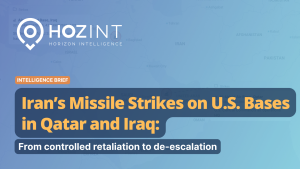Key Points
- On May 4, 2025, a hypersonic ballistic missile fired by Yemen’s Houthi rebels struck near Terminal 3 of Ben Gurion International Airport, Tel Aviv (TLV).
- Despite the presence of Israeli and U.S. air defense systems (Arrow and THAAD), the missile was not intercepted.
- The impact injured eight individuals and caused temporary disruption to airport operations.
- Major international airlines including Lufthansa, Delta, ITA Airways, and Air France suspended flights to and from Tel Aviv.
- The Houthis claimed the attack in retaliation for Israeli military actions in Gaza and threatened to enforce a full aerial blockade of Israeli airspace.
- On May 5, Israel retaliated with airstrikes against Houthi positions in Yemen.
- The incident reveals significant vulnerabilities in existing missile defense architectures and introduces new threats to aviation security at various altitudes.
Threat Context and Actor Capability
The ballistic missile strike on Ben Gurion International Airport by the Iran-backed Houthi movement marks a pivotal moment in the evolution of non-state actor capabilities. Traditionally operating within the Arabian Peninsula, the Houthis have demonstrated strategic reach by targeting Israeli territory over 2,000 kilometers away. This indicates an advanced level of technological support—most likely provided by Iran—and showcases a major enhancement in their missile inventory, now including hypersonic projectiles.
The use of a hypersonic ballistic missile is particularly concerning. These weapons travel at speeds exceeding Mach 5 and often incorporate maneuverability features that challenge conventional interception mechanisms. The fact that such a missile could strike near a major international airport, despite the presence of some of the most sophisticated missile defense systems, represents a fundamental shift in regional threat dynamics.
Impact on Aviation Operations and Risk Perception
The immediate impact of the missile strike included eight injuries and operational disruptions at Israel’s primary international gateway. More broadly, the attack sparked a significant reaction from the global aviation community. Leading international carriers suspended operations to and from Tel Aviv, reflecting the serious security and liability concerns posed by unpredictable missile threats.
These disruptions are indicative of a heightened sensitivity to missile-related risks in civil aviation. Airports, by their nature, are fixed and exposed targets, and their proximity to dense urban populations makes them particularly vulnerable to both the kinetic and psychological effects of attacks. The fact that a missile could evade interception and reach a location so close to a major passenger terminal undermines confidence in airspace safety and operational continuity.
Geopolitical and Strategic Implications
The attack brings into question the robustness of Israel’s multi-tiered missile defense infrastructure, particularly against next-generation threats like hypersonic weapons. This architecture includes:
- Iron Dome for short-range rocket threats;
- David’s Sling for medium to long-range missile defense;
- Arrow-2 and Arrow-3 for high-altitude, long-range ballistic missile threats;
- THAAD (deployed by the U.S. to support Israeli defenses).
Despite this layered configuration, the hypersonic missile successfully penetrated defenses. The reasons are multifaceted:
- Speed and Maneuverability: Hypersonic missiles travel faster than Mach 5 and can change trajectory mid-flight, making prediction-based interception ineffective.
- Altitude Range: These weapons often operate in the upper atmosphere (40–100 km), a region where radar detection is less reliable and defense systems are not fully optimized.
- Sensor Limitations: Current radar and satellite tracking systems may not provide sufficient resolution or lead-time to cue interceptors against hypersonic threats.
This technological gap illustrates the need for a strategic overhaul in missile defense paradigms, especially in regions where asymmetric actors possess advanced armaments.
Altitude-Related Threats to Civil Aviation
The evolving threat landscape also requires reconsideration of the risk profile associated with different flight altitudes:
- Cruising Altitude (30,000–40,000 ft): While traditionally safe from ground-based threats, these altitudes are increasingly vulnerable to advanced long-range systems such as hypersonic missiles or strategic SAMs.
- Approach and Departure Phases (<10,000 ft): These remain the most dangerous segments of flight due to slower speeds, lower altitudes, and proximity to populated or conflict-prone areas. The Ben Gurion attack occurred near Terminal 3—underscoring risks during these phases.
- Grounded Aircraft and Airport Infrastructure: Fixed assets on the tarmac are susceptible to collateral or targeted damage from missile strikes. Even near-miss incidents can result in major disruptions and cascading cancellations across global networks.
If the Houthi threat to impose a comprehensive aerial blockade materializes, Israel’s aviation sector could experience prolonged operational uncertainty, impacting not just national mobility but also regional and international airspace configurations.
Security and Policy Recommendations
- Revise Missile Defense Integration: Focused R&D and procurement to address hypersonic threats through advanced tracking systems, real-time data fusion, and kinetic/non-kinetic intercept technologies.
- Harden Airport Infrastructure: Improve protective shelter design, critical asset dispersion, and response drills for airport personnel and passengers.
- Dynamic Threat Intelligence for Airlines: Enhance intelligence sharing between governments, airlines, and international aviation bodies to ensure timely risk reassessment.
- Develop International Crisis Protocols: Encourage ICAO and IATA to spearhead frameworks for managing aviation threats from non-state actors wielding strategic-level weapons.
Conclusion
The missile attack on Ben Gurion International Airport by the Houthi movement signifies a watershed in aviation security. It challenges the assumption that sophisticated missile defense systems are adequate to protect critical infrastructure and airspace. More alarmingly, it marks the introduction of hypersonic weaponry into the hands of irregular actors, blurring the lines between state and non-state strategic capabilities. For aviation stakeholders, this incident necessitates a paradigm shift in threat modeling, risk management, and crisis response planning to safeguard global air transport against emerging, high-speed, and unpredictable threats.




